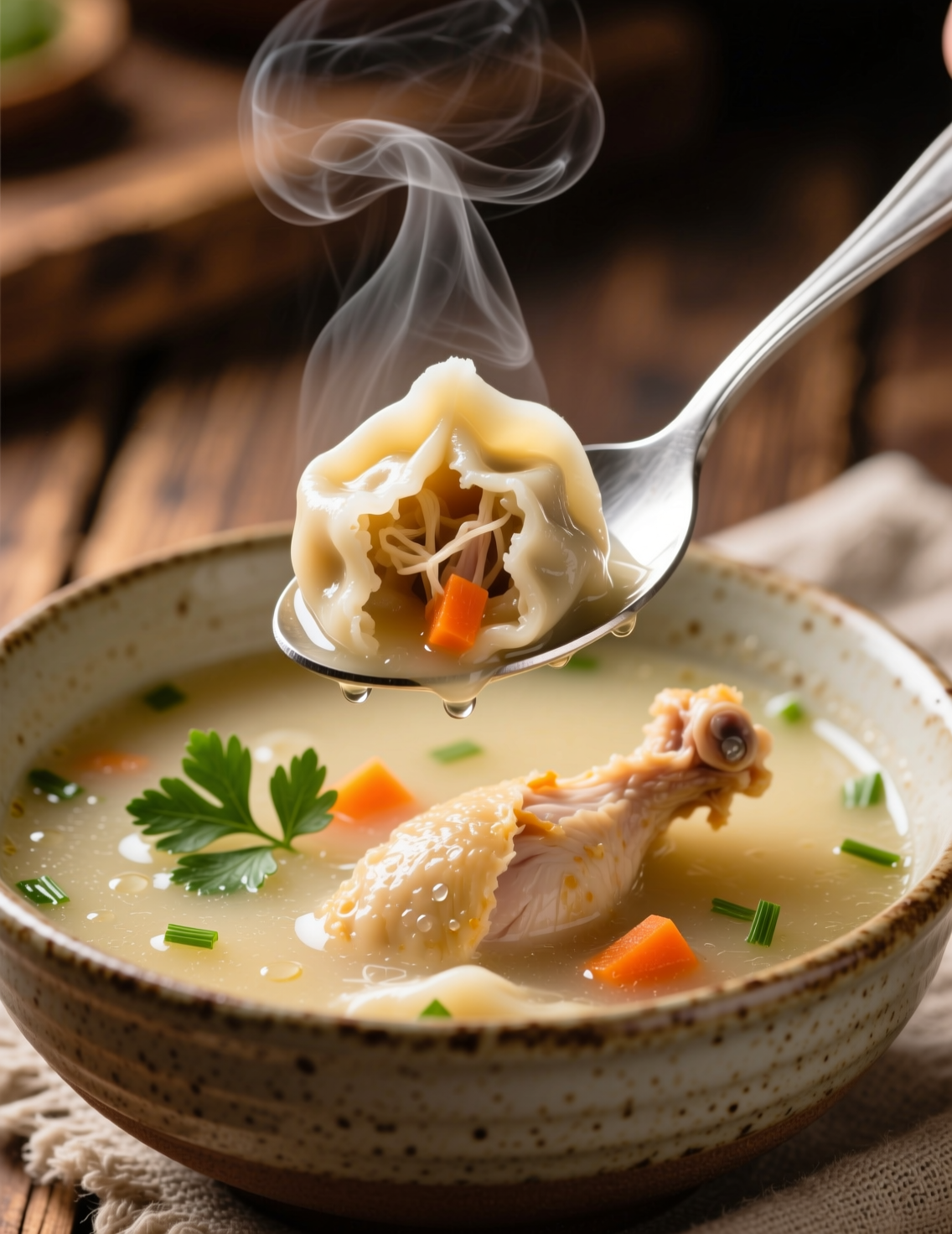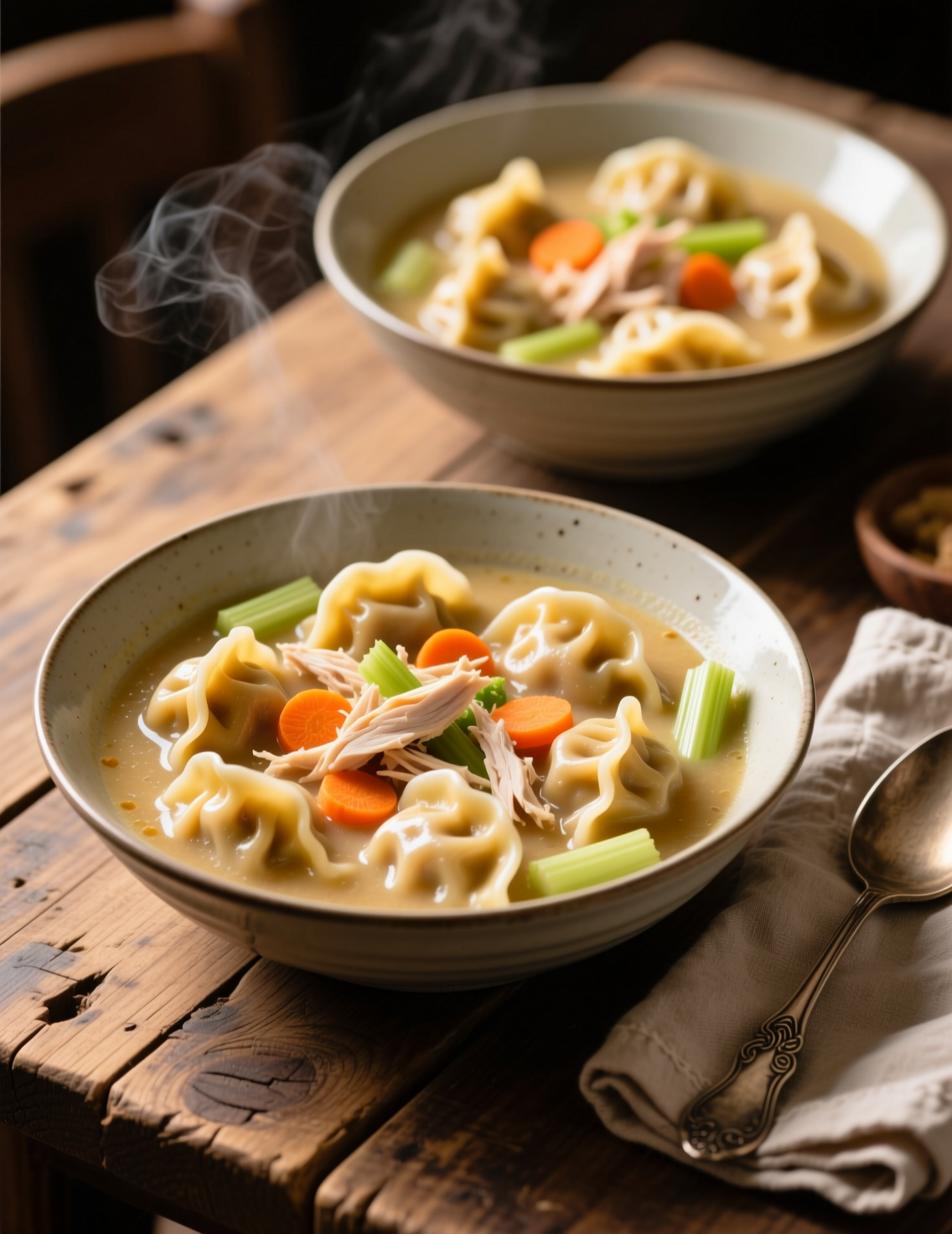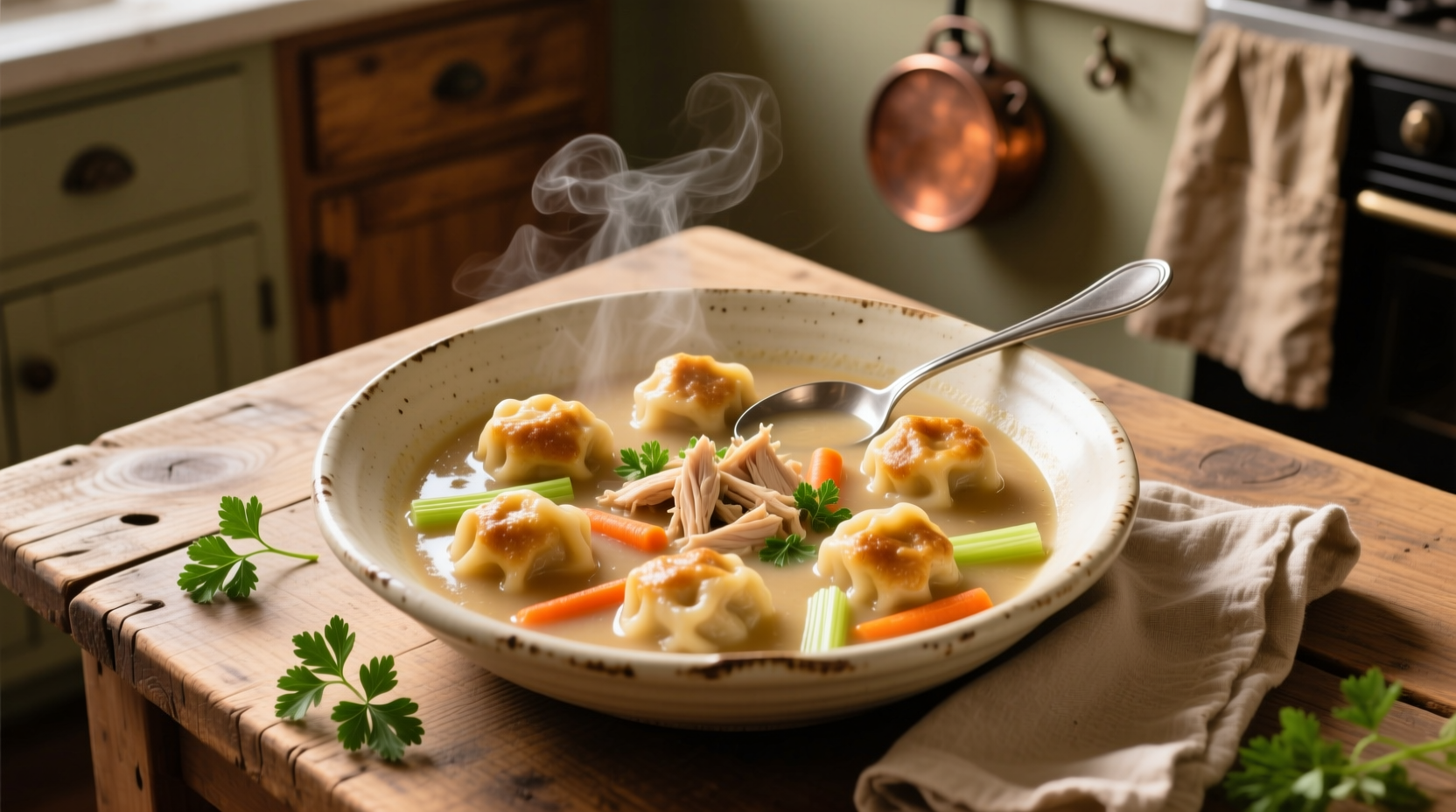There’s something about chicken and dumplings that feels like time travel. A dish so simple on the outside but carrying centuries of culinary history. This recipe for 6 servings isn’t just about making food—it’s about preserving a craft. I’ll walk you through the science, the technique, and the artistry behind this dish. And yes, a few quirky kitchen truths I’ve picked up along the way.
Why Chicken and Dumplings Still Matter
Chicken and dumplings isn’t fancy food. It’s humble food. But humble food often hides the deepest skills. In the 19th century, this dish was common in the American South, where families stretched a whole chicken with flour-based dumplings to feed many mouths. The same idea exists in German knödel, Chinese dumplings, and even Italian gnocchi. The logic is universal: make protein last by surrounding it with dough.
Professionally, chefs still return to chicken and dumplings because it teaches control. Control of stock reduction. Control of dough texture. Control of timing so the dumplings steam perfectly without disintegrating. This dish is both forgiving and merciless.
Ingredients Breakdown for 6 Servings
When scaling a recipe for 6 people, precision matters. Too little chicken and the dish feels thin. Too much, and it overwhelms the dumplings. Here’s the balanced list:
- 2 ½ pounds bone-in chicken (legs and thighs preferred)
- 2 tablespoons olive oil or neutral fat
- 1 large onion, diced small
- 3 carrots, peeled and sliced
- 3 celery stalks, sliced
- 4 garlic cloves, minced
- 8 cups chicken stock (homemade if possible, unsalted)
- 2 bay leaves
- 1 teaspoon dried thyme or 2 teaspoons fresh
- 2 teaspoons kosher salt (adjust later)
- ½ teaspoon freshly ground black pepper
For the dumplings:
- 2 cups all-purpose flour
- 1 tablespoon baking powder
- ½ teaspoon baking soda
- 1 teaspoon salt
- 3 tablespoons unsalted butter, cold, cubed
- 1 cup buttermilk
Optional enrichments: ½ cup heavy cream at the end, or fresh herbs like parsley for finish.
Professional note: never overload dumplings with herbs or cheese. It ruins the delicate steaming process and makes them dense.

Building the Flavor Base
Start with the chicken. Always sear bone-in chicken pieces before simmering. The Maillard reaction adds depth that straight-boiling will never achieve. I’ve seen chefs skip this step in volume cooking, and the result is flat broth. Browning the chicken in olive oil until golden—around 5 minutes per side—creates a foundation of flavor.
Remove the chicken, then add your mirepoix: onion, carrot, celery. Cook until softened but not browned. Garlic comes last, just 1 minute, otherwise it burns and turns bitter. That tiny detail separates clean-tasting broth from one with a harsh after-note.
The Stock Science
Add back the chicken and cover with chicken stock. Toss in bay leaves and thyme. Let it simmer gently for 45 minutes. Don’t let it boil hard. That breaks apart proteins, clouds the broth, and toughens meat. A simmer should look like lazy bubbles breaking the surface, not a rolling boil.
Once chicken is tender, remove it, shred into bite-size pieces, and return to pot. Bones can go back for extra extraction, but strain them before dumplings. Professionals often skim surface fat while simmering, but I keep some in. A thin sheen of fat gives dumplings extra flavor as they steam.
Dumplings: The Decisive Moment
The dumpling dough is deceptively simple. Flour, leavening, fat, liquid. But the devil lives in handling. Overmixing = hockey pucks. Undermixing = uneven pockets that collapse.
I rub cold butter into flour until pea-sized. Then pour in buttermilk, stir until just combined. The dough should look shaggy, sticky, a bit messy. If it looks smooth, you went too far.
Drop tablespoonfuls directly onto the simmering broth. Cover the pot tightly. Steam is your invisible friend here. Never lift the lid for at least 15 minutes. Every time you peek, you lose steam and the dumplings turn gummy.
Texture Control
A good dumpling should be tender inside, fluffy but not bready. Professionals test doneness by inserting a skewer—if it comes out clean, it’s ready. Time ranges between 15–20 minutes depending on size.
Some chefs swear by rolling dumplings into neat balls, but I find rough spoonfuls give better texture. Uneven edges grab broth and flavor, while smooth ones repel it.
Variations Across Kitchens
Regional styles change everything. In the South, dumplings are often flat, almost like thick noodles, rolled and cut before simmering. In the Midwest, drop-style dumplings dominate. Both are valid, but the rolled version demands more kneading skill and tends to risk toughness if handled carelessly.
A professional kitchen may enrich dumpling dough with cream or egg yolk. This creates richer flavor but heavier texture. For 6 servings at home, stick with buttermilk—it balances lightness and tang.
Common Mistakes and Fixes
Mistake 1: Dumplings sink and fall apart. This usually means the broth was boiling too hard, breaking them up. Lower the heat and maintain gentle steam.
Mistake 2: Gummy centers. That comes from lifting the lid too early. Once covered, trust the steam.
Mistake 3: Bland flavor. Dumplings absorb seasoning from the broth, so under-seasoned stock = underwhelming dish. Always taste and adjust salt before dumplings go in.
Nutritional and Practical Insights
A serving of chicken and dumplings roughly contains 450–500 calories, with 30 grams protein and 45 grams carbs. The protein-to-carb ratio makes it filling but not overwhelming. It’s practical for family-style meals where one pot feeds six without needing extra side dishes.
Interestingly, a 2022 survey by the National Chicken Council found that chicken remains the number one protein in U.S. households, consumed by 95% of Americans at least once a week. Dishes like chicken and dumplings are part of why—it uses every part of the bird economically.

Professional Touches That Elevate
Add a splash of cream at the end for luxurious texture. Garnish with fresh parsley for brightness. For restaurant plating, serve in wide bowls, dumplings sitting on top of chicken, with a drizzle of infused oil (thyme oil works wonders).
Another pro move: simmer a Parmesan rind in the stock for 20 minutes before adding dumplings. It deepens umami without altering authenticity.
Questions That Always Come Up
Can you make it ahead?
Yes, but only the broth and chicken. Dumplings don’t reheat well. Make fresh dumplings right before serving.
Can it be frozen?
The base freezes beautifully, up to 3 months. But again, dumplings don’t survive freezing.
Can you swap buttermilk?
Absolutely. A mix of milk and a teaspoon of vinegar makes a decent substitute. Yogurt thinned with milk works too.
Gluten-free option?
Rice flour with xanthan gum can mimic the structure. The texture is softer, but workable.
Emerging Trends
Chefs are rethinking traditional comfort food with modern twists. Some replace chicken with turkey or duck. Others infuse dumplings with spices like turmeric or smoked paprika. Plant-based variations are appearing, using jackfruit for the “chicken” and chickpea flour dumplings.
The push is clear: respect tradition, but adapt it to evolving diets. A dish like chicken and dumplings proves resilient in the face of culinary change.
Final Thoughts
Cooking chicken and dumplings for 6 isn’t just filling bowls—it’s carrying forward a culinary story. Every step, from searing chicken to steaming dumplings, teaches patience and precision. The beauty of this dish lies in its duality: simple enough for home cooks, technical enough for professionals to refine endlessly.
If you’re a chef, use it as training for younger cooks in your kitchen. If you’re a home cook, treat it as a dish that builds skill quietly, while feeding everyone at the table. And remember—never lift the lid too soon.
FAQs
Can I use boneless chicken for chicken and dumplings?
Yes, but bone-in chicken gives deeper flavor to the broth.
How do I know when the dumplings are cooked?
Insert a skewer—if it comes out clean, the dumplings are done.
Can I make the dumplings ahead of time?
No, dumplings should always be cooked fresh in the broth.
What if I don’t have buttermilk for the dumplings?
Use milk mixed with vinegar or lemon juice as a quick substitute.
Can chicken and dumplings be frozen?
Only the chicken and broth freeze well, not the dumplings.
Why did my dumplings turn gummy?
You probably lifted the lid too early while they were steaming.
What vegetables can I add besides carrot and celery?
Parsnips, peas, or green beans work well without overpowering flavor.
Can I make this recipe gluten-free?
Yes, use rice flour with xanthan gum for the dumplings.
How many people does this recipe serve?
It’s designed to serve 6 generous portions.
What’s the best garnish for chicken and dumplings?
Fresh parsley or a splash of cream adds brightness and richness.

Mariana is a passionate home cook who creates delicious, easy-to-follow recipes for busy people. From energizing breakfasts to satisfying dinners and indulgent desserts, her dishes are designed to fuel both your body and hustle.
When she’s not in the kitchen, she’s exploring new flavors and dreaming up her next recipe to share with the Foodie Hustle community.

